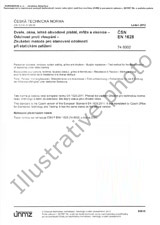We need your consent to use the individual data so that you can see information about your interests, among other things. Click "OK" to give your consent.
ČSN EN IEC 61970-457 (334910)
Energy Management system application program interface (EMS-API) - Part 457: Dynamics profile
Translate name
STANDARD published on 1.10.2021
The information about the standard:
Designation standards: ČSN EN IEC 61970-457
Classification mark: 334910
Catalog number: 512758
Publication date standards: 1.10.2021
SKU: NS-1036914
The number of pages: 468
Approximate weight : 1435 g (3.16 lbs)
Country: Czech technical standard
Category: Technical standards ČSN
The category - similar standards:
Annotation of standard text ČSN EN IEC 61970-457 (334910):
This part of IEC 61970 specifies a standard interface for exchanging dynamic model information needed to support the analysis of the steady state stability (small-signal stability) and/or transient stability of a power system or parts of it. The schema(s) for expressing the dynamic model information are derived directly from the CIM, more specifically from IEC 61970-302.
The scope of this document includes only the dynamic model information that needs to be exchanged as part of a dynamic study, namely the type, description and parameters of each control equipment associated with a piece of power system equipment included in the steady state solution of a complete power system network model. Therefore, this profile is dependent upon other standard profiles for the equipment as specified in IEC 61970-452, CIM static transmission network model profiles, the topology, the steady state hypothesis and the steadystate solution (as specified in IEC 61970-456, Solved power system state profiles) of the power system, which bounds the scope of the exchange. The profile information described by this document needs to be exchanged in conjunction with IEC 61970-452 and IEC 61970-456 profiles´ information to support the data requirements of transient analysis tools. IEC 61970-456 provides a detailed description of how different profile standards can be combined to form various types of power system network model exchanges
These changes apply to this standard:
Rozhraní aplikačního programu pro systémy řízení elektrické energie (EMS-API) - Část 457: Profily dynamiky (Norma k přímému použití jako ČSN).
Change published on 1.8.2024
Selected format:Show all technical information.



 Cookies
Cookies
